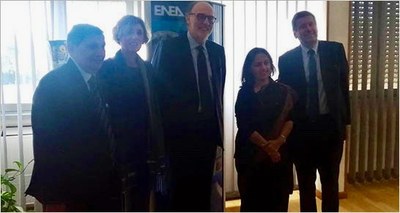Energy: ENEA and India join efforts for stronger S&T collaboration on technologies
21/11/2019
 Climate change is sadly becoming a deep-rooted reality of the globe overall, yet in southern Asia it is turning into an alarming challenge to tackle. What is happening today in India is now more than ever evident and known worldwide with its negative records on heavy air pollution and number of related casualties. The European Parliament’s Briefing Report on India’s environmental issues, published last April, well highlights this condition: «India…ranks 14th in the last United Nations global climate risk index and in 2017 it was the second most-affected country in terms of casualties related to extreme weather. Air quality in Indian cities is quickly deteriorating and it is today worse than the situation in China: in the 2018 World Health Organization (WHO) global ambient air quality database, 11 of the 12 cities with the highest levels of small particulate – PM2.5 – are located in India. Air pollution goes hand in hand with poverty: in 2016 an estimated 790 million people (almost 60 % of the Indian population), still relied on biomass for cooking. Deforestation, water pollution, clean water shortages, and waste management are further issues of concern».
Climate change is sadly becoming a deep-rooted reality of the globe overall, yet in southern Asia it is turning into an alarming challenge to tackle. What is happening today in India is now more than ever evident and known worldwide with its negative records on heavy air pollution and number of related casualties. The European Parliament’s Briefing Report on India’s environmental issues, published last April, well highlights this condition: «India…ranks 14th in the last United Nations global climate risk index and in 2017 it was the second most-affected country in terms of casualties related to extreme weather. Air quality in Indian cities is quickly deteriorating and it is today worse than the situation in China: in the 2018 World Health Organization (WHO) global ambient air quality database, 11 of the 12 cities with the highest levels of small particulate – PM2.5 – are located in India. Air pollution goes hand in hand with poverty: in 2016 an estimated 790 million people (almost 60 % of the Indian population), still relied on biomass for cooking. Deforestation, water pollution, clean water shortages, and waste management are further issues of concern».
Indian authorities have taken diverse initiatives to address these issues fast and best: firstly, India is a leading country in the implementation of the Paris Agreement. In this given framework, very recently the Embassy of India in Rome has officially requested ENEA to arrange an explorative meeting to join efforts and build strong S&T grounds for collaboration opportunities in the field of energy technologies above all. Prof. Federico Testa, President of ENEA, Dr. Gian Piero Celata, Head of the Energy Technologies Dept., Dr. Vinod Kumar Sharma, senior researcher of the Bioenergy, Biorefinery and Green Chemistry Division of the Territorial and Production Systems Sustainability Department, and Dr. Marina Leonardi, Head of International Relations, met H.E. Reenat Sandhu, the Ambassador of India in Rome, and Dr. Shyam Chand, Second Secretary of the Economic and Commercial Section of the Embassy of India.
Attention was drawn on the fact that India has an explicit interest in renewable energy in that there exist three separate sector-dedicated entities: the Ministry of New and Renewable Energy (MNRE), the Indian Renewable Energy Development Agency, and the International Solar Alliance. Actually India is trying to exploit energy from renewable energy sources, which currently account for 35% of the overall energy production. Yet the intention would be to make that percentage grow by using innovative, safe and sustainable energy technologies. Much interest has raised the CSP technology as a valid and better alternative to photovoltaics and fertile ground exists for a meeting between Indian and Italian researchers to be scheduled approximately next month, including a visit to the demonstration CSP plant and facilities located in the ENEA Casaccia Research Centre.
Prof. Testa also mentioned nuclear energy as a further common denominator between India and Italy. He also illustrated ENEA’s high expertise on IV generation nuclear energy, ITER reactor and DTT as another S&T collaboration item.
Actually, the Ambassador also expressed all her well-grounded concern about the extremely fast-growing pollution and the alarming environmental conditions made even worse by climate change, obsolete farming practices, anthropogenic actions and natural disasters. She focused particular attention on the need to address natural disasters. Just like Italy, India has a fragile hydrogeological reality and is often subject to catastrophic phenomena. The homologous authority to Italy’s Civil Protection Department is the Indian National Disaster Management Authority (NDMA), an agency of the Ministry of Home Affairs whose primary purpose is to coordinate response to natural or man-made disasters and for capacity-building in disaster resiliency and crisis conditions.
Hence the request by the Ambassador to create a bilateral coalition to develop together capacity building, technology transfer opportunities and install disaster-resilient infrastructure.
A third urgent issue to be addressed in India is water scarcity and pollution. On this side, Dr. Marina Leonardi mentioned the Nexus model as an example to be followed to forward mutual project proposals.
Summing up, H.E. the Ambassador of India has shown high interest in possibly arranging a number of meetings between researchers from ENEA and Indian counterparts in order to pave the way to exchanging ideas, expertise and proposals for future projects on three main technological offers: RES and nuclear energy, disaster-resilient infrastructure, and water treatment technologies.
The seeds of prolific collaboration have been successfully sown to meet and address so an important societal challenge.
More info:
Dr. Marina Leonardi – Head, International Relations Office
relint@enea.it; marina.leonardi@enea.it
https://twitter.com/IndiainItaly/status/1192386551818440704
http://www.europarl.europa.eu/RegData/etudes/BRIE/2019/637920/EPRS_BRI(2019)637920_EN.pdf
